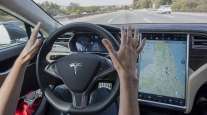How General Motors Became a Force in Autonomous Sector

Stacey Randecker Bartlett recently joined the race to develop self-driving cars. Literally.
Bartlett, who lives in the southeast part of San Francisco, was bicycling home — using Uber’s electric bike sharing system — when she decided to engage in a playful “chase” with a Cruise AV, one of General Motors Co.’s self-driving cars.
“I was keeping up on the hills on the JUMP bike — having a blast because I know they need cyclist practice,” Bartlett said, meaning that autonomous vehicles need to improve at navigating the streets with bicycles.
“We did that for a few blocks, and then it turned left up a wicked hill and I opted to turn right, start back towards home,” Bartlett said. “Then a Waymo goes the other way, and there I am giggling like a little girl. It’s the best!”
GM is in a race of its own. Its self-driving vehicle unit, GM Cruise, is running neck-and-neck with Waymo, a subsidiary of Google, to be first to bring fully autonomous cars to market. The two companies are considered the leaders in a crowded field, and San Francisco is the proving grounds to refine the technology.
RELATED: GM partners with tech investment firm to bring self-driving vehicles to market next year
GM is testing its own ride-sharing app in the Golden Gate City using its fleet of self-driving cars and a dispatch operation that works similarly to an air traffic control center. Self-driving technology is moving at lightning speed, with GM betting that autonomous vehicles (AVs) will be an important part of its business as people’s transportation needs and preferences change.
Here’s how GM got to the front and where it plans to go.
Testing grounds
GM bought Cruise in 2016 as a 40-person start-up. Today, it employs 740 people, GM Cruise spokesman Patrick Sullivan said, and it’s valued at more than 10 times what GM paid for it. The automaker paid about $1 billion for Cruise, and today it’s valued at more than $11 billion, according to TheStreet.com.
Adding to its value is SoftBank, a leading technology investor with stakes in such companies as Uber, planning to put $2.25 billion into GM Cruise Holdings, with GM investing $1.1 billion as part of the partnership.
The first Cruise AVs were Chevrolet Bolts, Chevrolet’s all-electric vehicle, which used two Lidar sensors on the roof. They came out the same year GM bought Cruise.

GM's SURUS autonomous concept vehicle, designed to haul goods and could be adapted for military use.(General Motors)
Last year, GM Cruise built 130 of the second generation of its AVs that had a bigger suite of sensors, Sullivan said. Then, last fall, it added 50 more. GM no longer calls them Bolts, but rather the Cruise AV, he said.
All the self-driving cars are electric and still have operating controls, such as a steering wheel and brakes. They are being tested mostly in San Francisco, with a handful deployed in Milford and the Phoenix area, Sullivan said.
“They have been mapping vehicles for New York City,” said Sam Abuelsamid, senior analyst at Navigant Research in Ann Arbor, Mich. “It’s now up to New York state as to when they will decide to give out driverless permits. They have not given it yet to any company.”
GM’s hushed start
GM also has quietly developed its own ride-sharing app called Cruise Anywhere, and has been testing it with its employees in San Francisco for about a year now.
Coinciding with the testing of the app, GM Cruise is also testing a dispatch platform in San Francisco, Abuelsamid said. He visited GM Cruise’s headquarters there last November, rode in an AV and saw the app.
The dispatch platform is a command center of sorts. People track the AVs in real time, monitor each AV’s battery charge level, and know if the cars are occupied or not. Dispatchers will be able to take control of the cars remotely in emergencies, Abuelsamid said.
RELATED: Amazon starts delivering goods to trunks of GMs, Volvos
GM Cruise declined to provide an executive to discuss the testing its doing, but representatives did confirm it is testing the ride-hailing app in San Francisco.
Also, GM leaders will not comment on which city GM will initially deploy fully autonomous cars, but most experts expect it will be San Francisco in early spring.
GM Cruise’s fleet of 180 all-electric AVs travel the hilly San Francisco streets now dozens of times a day, acting as a taxi-like service for employees only.
GM has also installed 18 fast chargers for the electric vehicles in a parking garage near the city’s busy Embarcadero eastern waterfront, sources said.
Like all AVs in the United States, the Cruise AVs must have a human on board for safety for now. But, observers say, its learning has made it a front-runner among competitors such as Waymo, Uber, Ford, Tesla and others to deliver on its promise to launch self-driving cars through a ride-sharing platform in 2019.
“GM and Waymo overall are the leaders,” said Abuelsamid, who publishes an annual Automated Driver Leader Board study. “GM’s technology is as good as Waymo’s and they have the capability to develop and service those vehicles. They’re in good shape.”

Mary Barra, CEOr of General Motors Co., speaks during an event at the company's Orion Assembly Plant in Orion Township, Mich., June 13, 2017. (Jeff Kowalsky/Bloomberg News)
Pretty normal
So far, AVs have mastered navigating safely around pedestrians and other cars, but they struggle to read bicyclists. That’s why Bartlett took one on.
She sees GM Cruise AVs “multiple times” daily around San Francisco, she said. Bartlett, who is a senior marketing manager for auto supplier Renesas Electronics America, works on “advanced automotive” and has an interest in autonomous cars.
She said GM Cruise, Uber, Waymo and Zoox are all testing AVs in San Francisco, but the Cruise AVs are by far the most commonly seen. Most have two to four people in them and run at all hours of the day, evenings and weekends, she said.
“I don’t know if they’re going around just for miles or they’re taking people places,” Bartlett said.
RELATED: Driverless tech part of SoftBank’s 300-year plan
Abuelsamid has been to San Francisco recently and he said, “It’s increasingly not unusual to see autonomous vehicles running around. It’s getting to be a pretty normal thing.”
How it works
In GM’s 2018 Self-driving Safety Report on autonomous vehicles, it describes how it would commercialize the AVs through a ride-sharing platform.
“Customers will use a mobile app to request a ride, just like they use ride-sharing today. The only difference is that customers will control the experience — their customized climate control and radio station settings will be sent to the vehicle ahead of when they access their ride,” the report said.
GM Cruise’s fleet operations will send an AV to a customer’s location and drive them to their destination, the report said. It went on to say once a customer is inside the car, there are “touch-screen tablets to access real-time status information about the ride. The tablets will also remind passengers to close all doors and fasten their seat belts. Passengers will be able to communicate with remote support personnel with the press of a button. There’s another button for passengers to press if they want to end a ride because of an emergency.”
Cruise will have human support staff to initiate contact with passengers when assistance is needed. The report said, “Once the ride is over, if passengers forget to close the doors, the vehicle can close them itself and move on to the next customer.”

A rendering of GM's autonomous Cruise (General Motors Co.)
Tangled webs
Since 2016, GM has had a $500 million investment in ride-sharing company Lyft. Lyft, in turn, has since formed partnerships with other automakers such as Ford and Jaguar Land Rover, said Abuelsamid.
GM leaders say they learned a lot about ride sharing from the investment in Lyft. GM learned to run a subscription service, Maven Gig. Maven Gig allows people to pay as little as $159 a week to rent a GM vehicle to use to make money driving for Uber or Lyft ride-sharing services, said Annalisa Bluhm, manager of urban mobility and Maven communications.
“From them, we learned design thinking,” said Bluhm. “Design thinking demands you have hands-on experience. That’s what gave us the opportunity to really understand what it takes to run a ride-sharing service. How do you truly be a service-based product versus we’re we are, which is retail based?”
In early June, GM President Dan Ammann left Lyft’s board. Between that move, GM’s new partnership with SoftBank, SoftBank’s ties to Uber and GM’s development of its own ride-sharing app, all signs could indicate that GM and Lyft are becoming more like competitors than partners. Not so, said Bluhm.
RELATED: Self-driving car pioneers are slowing down after crashes
“I don’t see us getting out of that Lyft partnership,” said Bluhm. “This space is so dynamic and huge and the market is undefined. It’s healthy to be having conversations with multiple partners as to what will work best.”
Analysts agree, saying the mobility space and technology are moving fast, so keeping options open is beneficial.
“A $500 million investment for GM is nothing, it’s a year of advertising. It’s not a lot of money for venture capital,” said Rebecca Lindland, executive analyst at Kelley Blue Book in New York. “But it’s capital investment in a very uncertain future. They have to test the waters.”
The partnership with SoftBank, Lindland said, indicates that GM likely believes Uber is “on the right path towards a combination of ride hailing and ride sharing with AVs. Lyft is not doing anything with AV.”
“GM is smart to look for a partner in this space because the investment levels are staggering,” said Lindland.
Trusting technology
So it now comes down to: When will GM put Cruise AVs on the street?
It plans to take them to market next year, GM leaders have said. But first, federal regulators must approve building the vehicles without any steering wheel or foot pedals, Bartlett said.
There is also solving the puzzle of how to make a profit running AVs in ride sharing, Abuelsamid said.
“Everyone is experimenting with the business model,” Abuelsamid said. “GM and Waymo will probably be the first to deploy commercialized vehicles in the next 12 months, but no one knows how much the general public will embrace this and how much they’ll pay for this service. And, it will be costly to maintain.”
RELATED: Fear of autonomous vehicles rises after high-profile roadway deaths
Then there is the question of when self-driving cars will be fully safe.
If an AV needs to get out of a situation, a remote human operator would take over from a command center somewhere, said Bartlett, adding, “Just like a remote-control car you had as a kid, only it could be across the world or some remote location.”
That’s good enough for Bartlett, who said she would feel completely safe riding in one. She would even let her kids ride in them.
“If a Cruise or a Waymo pulls up, I’d get in either one right now. I would trust the technology,” said Bartlett. “I think they’re at that level. I have seen them drive around the peninsula and the San Francisco area. They know where to go in 99% of situations.”
Distributed by Tribune Content Agency, LLC




